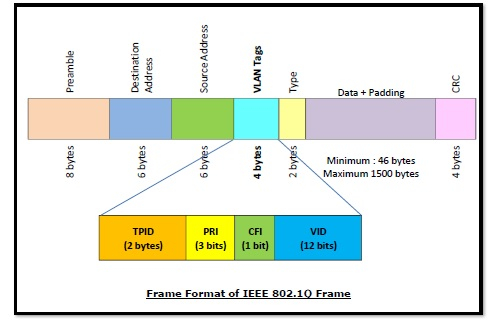
 Data Structure
Data Structure Networking
Networking RDBMS
RDBMS Operating System
Operating System Java
Java MS Excel
MS Excel iOS
iOS HTML
HTML CSS
CSS Android
Android Python
Python C Programming
C Programming C++
C++ C#
C# MongoDB
MongoDB MySQL
MySQL Javascript
Javascript PHP
PHP
- Selected Reading
- UPSC IAS Exams Notes
- Developer's Best Practices
- Questions and Answers
- Effective Resume Writing
- HR Interview Questions
- Computer Glossary
- Who is Who
The IEEE 802.1Q Standard
The IEEE 802.1Q networking standard lays down the specifications for VLANs (Virtual Local Area Networks or Virtual LANs) on an IEEE 802.3 Ethernet network. The standard is generally referred as Dot1Q. VLANs are a logical group of computers that appear to be on the same LAN irrespective of the configuration of the underlying physical network. Network administrators partition the networks to match the functional requirements of the VLANs so that each VLAN comprise of a subset of ports on a single or multiple switches or bridges. This allows computers and devices in a VLAN to communicate in the simulated environment as if it is a separate LAN.
Specifications laid down in IEEE 802.1Q
IEEE 802.1Q standard outlines the methods by which VLAN tags can be added to Ethernet frames, so that the frame can identify the VLAN to which it is destined to.
When a frame moves into a VLAN-enabled section of an Ethernet network, the tag is added to denote the VLAN membership. A frame can be within only one VLAN at a time.
IEEE 802.1Q also lays down the procedures that bridges and switches needs to adopt to manage VLAN tagged Ethernet frames.
Additionally, the standard can also define a quality-of-service (QoS) prioritization scheme as well as Generic Attribute Registration Protocol.
Frame Format of IEEE 802.1Q Frame
The main fields of a frame of classic Ethernet are −
- Preamble − An 8-byte starting field that provides alert and timing pulse for transmission.
- Destination Address − A 6-byte field containing physical address of destination stations.
- Source Address − A 6-byte field containing the physical address of the sending station.
-
VLAN Tags − A 4-byte field containing the following sub-fields −
- TPID − A 2-byte Tag Protocol IDentifier that denotes the frame type.
- PRI − A 3-bit priority field for assigning QoS priority.
- CFI − A single bit Canonical Format Indicator, denoting whether the MAC address is encapsulated in canonical format that shows compatibility with Ethernet and token ring frames.
- VID − A 12-bit field containing the ID of the VLAN to which the frame belongs to.
- Type/Length − A 2 byte field that stores the process or the length of the data field.
- Data and Padding − A variable sized field (46 – 1500 bytes) that carries the data from the upper layers.
- CRC − A 4 – byte error detection field. (CRC stands for cyclic redundancy check)


